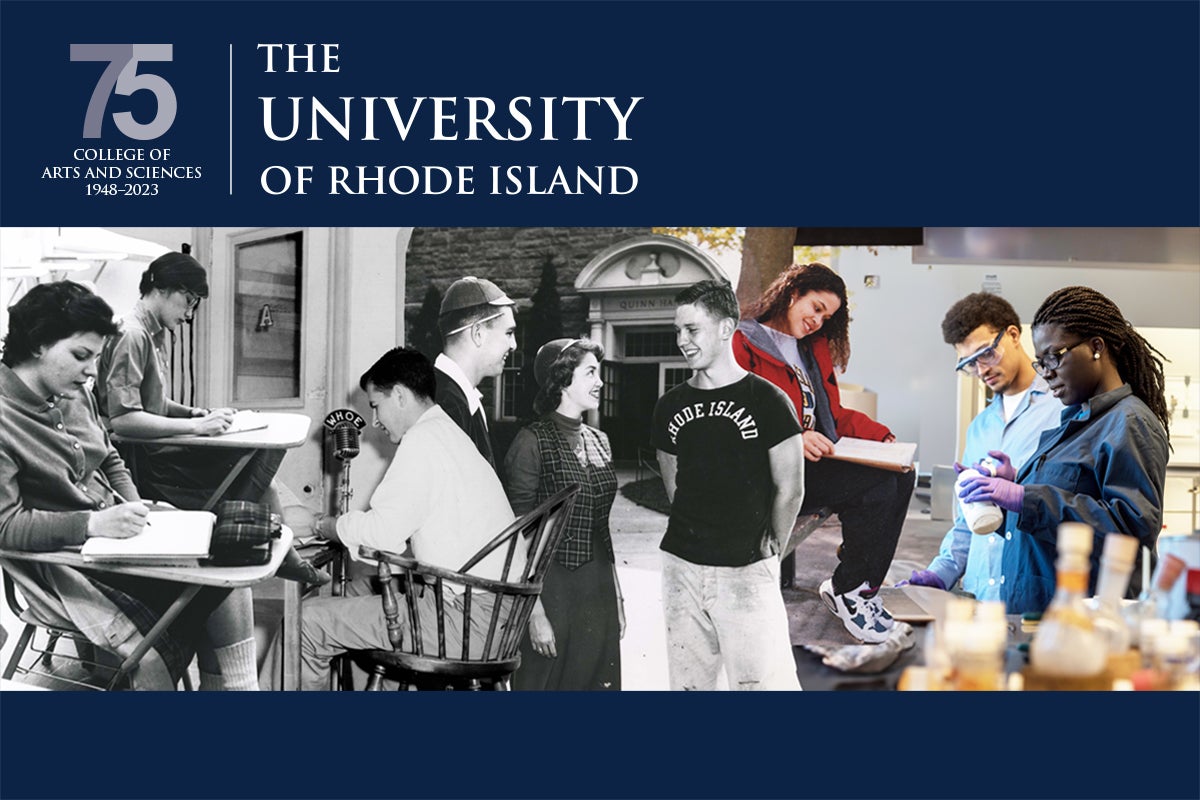KINGSTON, R.I. — Sept. 11, 2023 — In 1939, a group of prominent Rhode Island leaders and educators delivered a key report to the Rhode Island General Assembly. It addressed a proposal to create the University of Rhode Island from what was then Rhode Island State College.
The report’s conclusion: The institution was not ready for such a move. The main reason was that it lacked a liberal arts program, which would be “the foundation stone of the edifice” of a university.
In 1948—75 years ago—that foundation stone was put into place. In that year, the Board of Trustees created the School of Arts and Sciences, which became a college three years later when the University of Rhode Island was officially renamed. This year, URI celebrates the creation of the college that helped to create the University as it is today. All semester long, the public is invited to attend events that showcase the college’s rich scholarly community—from music and theater performances, art exhibitions, public lectures, and more. A continually updating schedule of events is available at uri.edu/artsci/75th-anniversary/.
At its founding, the college offered just six majors and several minors. It has now expanded to include 58 degree programs, more than 4,000 graduate and undergraduate students with Arts and Sciences majors, and 350 faculty members—making it the largest college at URI. Nearly every student at URI takes at least one class offered by the college.
Jeannette Riley, dean of the College of Arts and Sciences, says that while much has changed in the college over the past 75 years, the central mission remains the same.
“The core skills of an arts and sciences education—the ability to critically analyze information, solve problems, communicate effectively, and see the world from other perspectives—remain critical skills in the workforce and in society at large,” said Riley. “I think what has changed is that we’ve become more intentional about demonstrating how those skills can be applied, and we’re equipping students with new tools to put those skills into practice.”
An example of that new emphasis of putting skills into practice is the college’s career readiness program—a four-year path that helps to prepare students for the modern job market. The program includes peer and alumni mentorship opportunities, workshops that connect majors to careers, internship and undergraduate research opportunities, and introductory classes in data visualization, computer coding, and other emerging workplace competencies. Students are eligible for financial awards to help offset costs associated with unpaid internships and summer research and creative project opportunities.
“The key is the experiential component,” Riley said. “We know that project-based work and internships help students to engage in their college careers as well as provide a leg up after graduation. We’re working to expand those opportunities and make them available to everyone, including those who wouldn’t normally be able to take a summer off of work to take advantage of these opportunities.”
The college is also focused on creating new programs and initiatives that address emerging areas of study. Earlier this year, the physics department launched a new quantum initiative aimed at developing the workforce to drive the coming quantum computing revolution. Meanwhile, the Harrington School of Communication and Media developed a new certificate program in social media that provides key skills for business and non-profit communication. The Department of Modern and Classical Languages and Literatures, with a primary focus on language proficiency and intercultural competency, supports more than 600 students pursuing a language major. It also hosts the Chinese Language Flagship Program, one of 13 unique programs in the United States where students can progress from a beginner level to professional fluency in Mandarin Chinese.
At the same time, the college is making key investments to provide students with cutting-edge facilities for learning inside and outside the classroom. Last year, with the philanthropic support of Richard and Jean Harrington and other donors, renovations were completed on Ranger Hall, which provides the Harrington School with a dedicated home in the heart of campus. And work is underway on a $57.3 million upgrade to the URI Fine Arts Center, including an 82,000-square-foot academic building, supported by a bond approved by Rhode Island voters.
The college is also renewing its efforts to make an immediate impact in communities in Rhode Island and around the world through the work of its institutes and outreach programs. Last year, the Center for Nonviolence and Peace Studies launched CIRIGHTS—the largest quantitative database measuring global human rights. The Social Science Institute for Research, Education, and Policy engages students and faculty in addressing pressing issues facing Rhode Island communities. The Center for the Humanities sponsors a community lecture series that brings to campus leading minds from all over the world. The center also provides funding for student and faculty research and creative projects.
While the founders of the college saw it as the cornerstone to a proper university, Riley says they likely could never have predicted the direction it would take 75 years later.
“The beauty of our college is that we can build on our rich history,” Riley said. “Programs and classes that have been crucial since our founding—languages, philosophy, political science, sociology—now thrive side-by-side with emerging endeavors like data science and quantum information. It’s such an exciting time for the College of Arts and Sciences as well as the University of Rhode Island. We’re looking back over our first 75 years while we look forward to a bright and dynamic future.”

